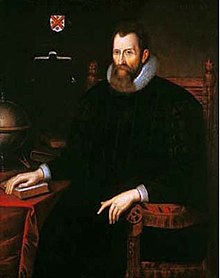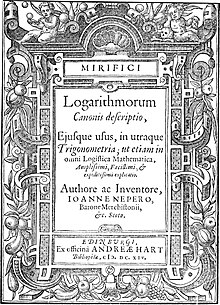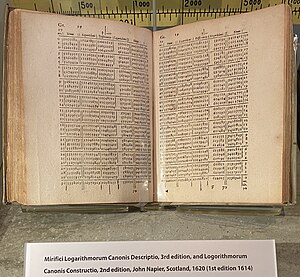
Back Mirifici Logarithmorum Canonis Descriptio Spanish לוח הלוגריתמים של נאפייר HE Mirifici Logarithmorum Canonis Descriptio ID Mirifici Logarithmorum Canonis Descriptio Italian



Mirifici Logarithmorum Canonis Descriptio (Description of the Wonderful Canon of Logarithms, 1614) and Mirifici Logarithmorum Canonis Constructio (Construction of the Wonderful Canon of Logarithms, 1619) are two books in Latin by John Napier expounding the method of logarithms. While others had approached the idea of logarithms, notably Jost Bürgi, it was Napier who first published the concept, along with easily used precomputed tables, in his Mirifici Logarithmorum Canonis Descriptio.[1][2][3]
Prior to the introduction of logarithms, high accuracy numerical calculations involving multiplication, division and root extraction were laborious and error prone. Logarithms greatly simplify such calculations. As Napier put it:
“…nothing is more tedious, fellow mathematicians, in the practice of the mathematical arts, than the great delays suffered in the tedium of lengthy multiplications and divisions, the finding of ratios, and in the extraction of square and cube roots… [with] the many slippery errors that can arise…I have found an amazing way of shortening the proceedings [in which]… all the numbers associated with the multiplications, and divisions of numbers, and with the long arduous tasks of extracting square and cube roots are themselves rejected from the work, and in their place other numbers are substituted, which perform the tasks of these rejected by means of addition, subtraction, and division by two or three only.”[2]: Preface
The book contains fifty-seven pages of explanatory matter and ninety pages of tables of trigonometric functions and their Napierian logarithms.[1]: p. 18 These tables greatly simplified calculations in spherical trigonometry, which are central to astronomy and celestial navigation and which typically include products of sines, cosines and other functions. Napier describes other uses, such a solving ratio problems, as well.[2]: Preface
John Napier spent 20 years calculating the tables.[4]: p. 16 He wrote a separate volume describing how he constructed his tables, but held off publication to see how his first book would be received. John died in 1617. His son, Robert, published his father's book, Mirifici Logarithmorum Canonis Constructio, with additions by Henry Briggs in 1619. [5] [6] The Constructio details how Napier created and used three tables of geometric progressions to facilitate the computation of logarithms of the sine function.
- ^ a b Ernest William Hobson (1914), John Napier and the invention of logarithms, 1614, Cambridge: The University Press
- ^ a b c Napier, John (1614). The Description of the Wonderful Canon of Logarithms. Translated by Wright, Edward; Bruce, Ian. 17centurymaths.com. Retrieved March 14, 2022.
- ^ Napier, John (1614), Mirifici Logarithmorum Canonis Descriptio [The Description of the Wonderful Rule of Logarithms] (in Latin), Edinburgh, Scotland: Andrew Hart
- ^ Roegel, Denis (2010). "Napier's ideal construction of the logarithms, Research Report inria-00543934". HAL. INRIA. Retrieved 13 March 2022.
from the Loria Collection of Mathematical Tables
- ^ Napier, John; Briggs, Henry (1619). Mirifici Logarithmorum Canonis Constructio (in Latin). Edinburgh: Andres Hart.
- ^ Napier, John (1889) [1620]. The Construction of the Wonderful Canon of Logarithms. Translated by Macdonald, William Rae. Edinburgh: Blackwood & Sons.
Also available on Wikisource
© MMXXIII Rich X Search. We shall prevail. All rights reserved. Rich X Search